Hanging Succulents: Vining or Trailing Succulents for Hanging Baskets
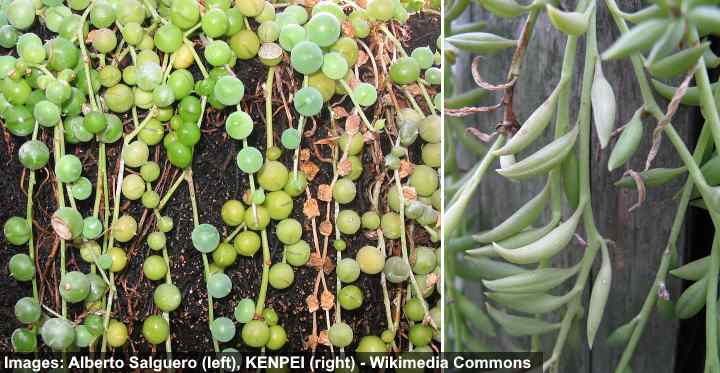
Hanging succulents have long trailing vines that look spectacular in hanging baskets. The best succulents for hanging baskets have dangling stems with fleshy leaves, and some may even flower. Trailing succulents generally grow best in partial shade and don’t require much maintenance. You can also grow hanging succulents indoors or outdoors, depending on the climate.
Some of the best and most popular hanging succulents are plants with string-type vines. String of Pearls, String of Dolphins, String of Nickels, and String of Buttons are a few examples of popular string succulents.
Other types of succulents and cacti with fleshy stems and leaves also look spectacular hanging from baskets. For example, Hindu Rope, Burro’s Tail, and Calico Kitten have long fleshy vines that dangle down. Monkey’s Tail cactus and Queen of the Night are eye-catching types of hanging cactus plants.
This article is a guide to the best types of succulents and cacti for hanging baskets. You’ll also find out how to care for trailing succulents in your home.
Trailing Succulents vs. Hanging Cacti
Many types of hanging succulents and cacti for hanging baskets seem like similar plants. However, there is a difference between succulents and cacti. Both cacti and succulents are fleshy plants that store water. However, succulents are a broad group of fleshy-leaved plants that include cacti.
Botanically speaking, cacti are a sub-category of succulent plants. Hanging cacti generally don’t have leaves but have long, thick cylindrical or flat leafless stems that grow around 6.5 ft. (1.8 m) long.
Hanging succulents can include cacti. However, they also include a wide range of plants with trailing stems that have leaves and, sometimes, flowers.
How to Choose Succulents for Hanging Baskets
The two principal factors when choosing a hanging succulent is location and height. Most succulents in hanging baskets require bright, indirect sunlight or full sunlight. Hanging basket succulents and cacti aren’t generally plants that survive without sunlight.
Some hanging cacti and succulents can grow exceptionally long. For example, Donkey’s Tail dangling stems can reach 4 ft. (1.2 m) long, and Rat Tail cactus hanging stems can dangle up to 6 ft. (1.8 m) below the pot. Of course, pruning hanging succulents can help control their length.
Low maintenance is a benefit of growing hanging succulent plants indoors. Generally, cacti and succulents need less watering than regular houseplants. In the summertime, you may only need to water the plants once a week.
The Best Hanging Succulents
Let’s look in more detail at the best hanging succulents that you can grow indoors. Most succulents thrive outdoors in zones 9 through 12. If you live in a warm climate, you can also hang these succulents outside to decorate a porch, deck area, arbor, or fence.
String of Pearls (Senecio rowleyanus)
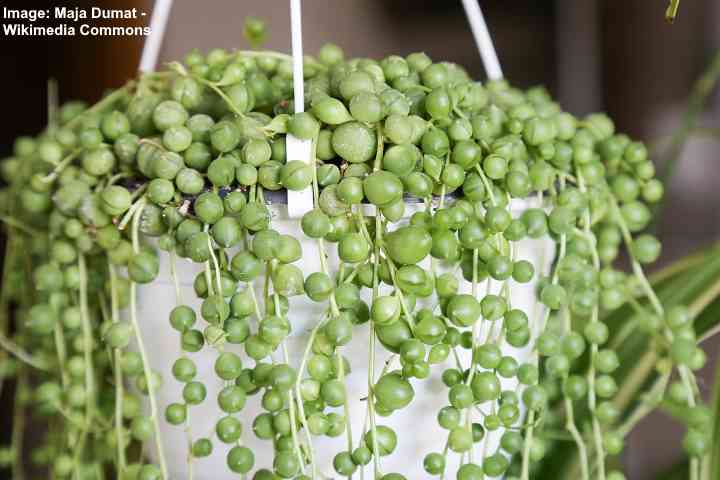
String of pearls is a beautiful hanging succulent with fleshy round leaves
String of Pearls is a hanging succulent with long, thin, thread-like stems with small globular pea-sized leaves. Also called String of Beads, this popular hanging succulent has wiry stems that drape over pots between 1 and 3 ft. (0.3 – 1 m) long. The vining succulent also blooms with small, fragrant white flowers.
Grow String of Pearls in a hanging basket or pot and place in a sunny location. Like growing many types of succulents, protect the delicate succulent from direct sunlight. To create a cascading display of green beads, plant many stems together in a pot.
You can grow String of Pearls outdoor if you live in zones 9 through 12. The vining succulent will spread along the ground where its necklace-like stems will root in the soil. String of Pearls grows best in rock gardens as ground cover for full sun.
String of Bananas (Senecio radicans)
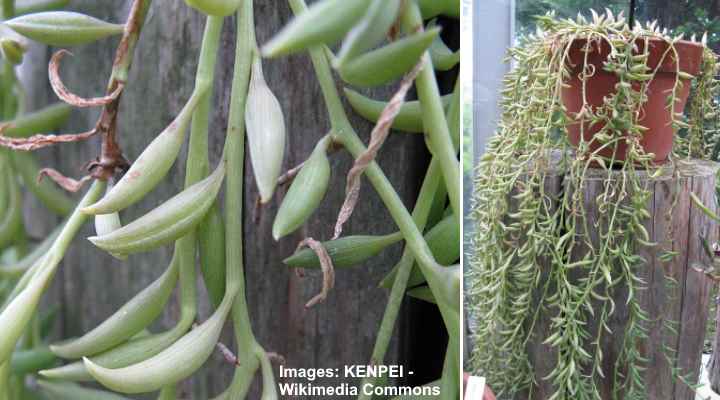
String of bananas is a trailing succulent which looks great in hanging baskets
String of Bananas is a trailing succulent with draping stems that grows masses of green, banana-shaped leaves. String of Bananas is also a flowering succulent with small cinnamon-scented flowers that are creamy-white. The slender vining stems with the “fish-hook” leaves are the attractive feature of this succulent.
String of Bananas (also called String of Fishhooks) has succulent dangling stems growing up to 3 ft. (1 m) long. Grow this low-maintenance plant in indirect sunlight and water occasionally to keep the soil partly moist.
You can also propagate the string succulents easily by snipping off some stems and placing them in the soil. The fleshy leaves on the stringy stems will soon take root.
String of Dolphins (Senecio hippogriff)
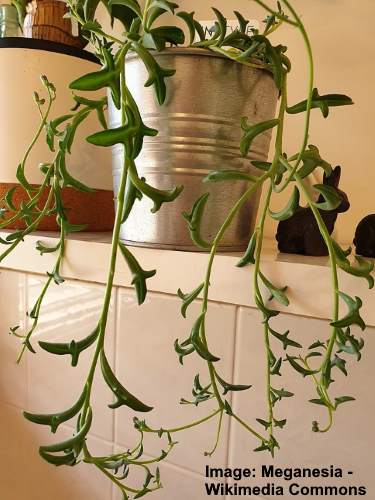
String of dolphins succulent has cascading growth habit suitable for hanging baskets
String of Dolphins is another string-like succulent that is ideal for hanging baskets. The String of Dolphins has fascinating fleshy foliage that looks like dolphins jumping off cascading stems. The “dolphin necklace” succulents also produce insignificant fuzzy flowers that are an off-white color.
Like most vining succulents, grow String of Dolphins in bright light, protected from direct sunlight. Water the drought-tolerant succulent every so often so that the soil doesn’t dry out.
Although String of Dolphins rarely flowers indoors, its fascinating dolphin leaves compensate for any lack of flowers.
Related reading: How to make the best soil for succulent houseplants.
String of Tears (Senecio herreianus)

String of tears is a type of hanging succulent with oval fleshy leaves
String of Tears is a hanging succulent with cascading stems and small oval, fleshy green leaves. The plump leaves are in a tear shape and have dark green stripes running from top to bottom. The egg-shaped leaves’ unusual pattern gives Senecio herreianus the common names String of Watermelons, Gooseberry Plant, and String of Raindrops.
This unusual hanging plant looks like the String of Pearls and can be easily confused, however it has oval rather than globular fleshy leaves. Like many types of string succulents, the dangling stems grow to around 3 ft. (1 m) long.
Place a hanging basket with String of Tears plant in indirect light, ideally near an east- or west-facing window.
String of Nickels (Dischidia nummularia)
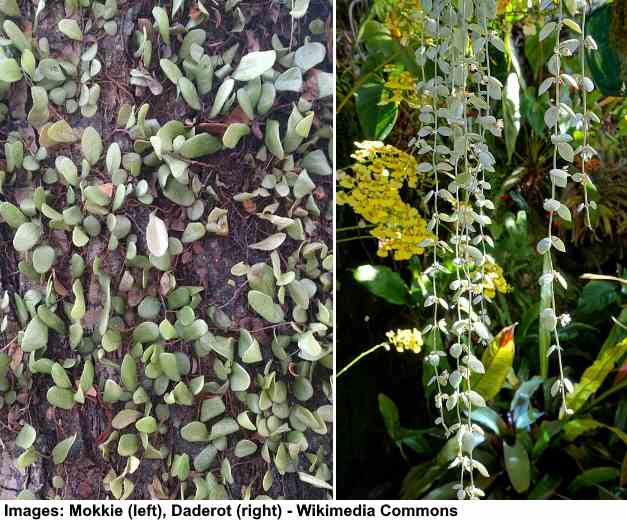
String of nickels hanging succulent thrives in high humidity
String of Nickels has round flat leaves that look like a smooth green coin. Also called the Button Orchid or String of Coins, the long cascading strands spill over hanging baskets or containers. The decorative vines can grow up to 18” (45 cm) long, and the coin leaves measure 0.6” (1.5 cm) across.
String of Nickels is a type of epiphyte plant that requires high humidity to grow well. The Dischidia nummularia thrives when you mist its fleshy leaves daily. It would be best if you only watered the succulent enough to prevent the soil from drying out.
String of Buttons (Crassula perforata)
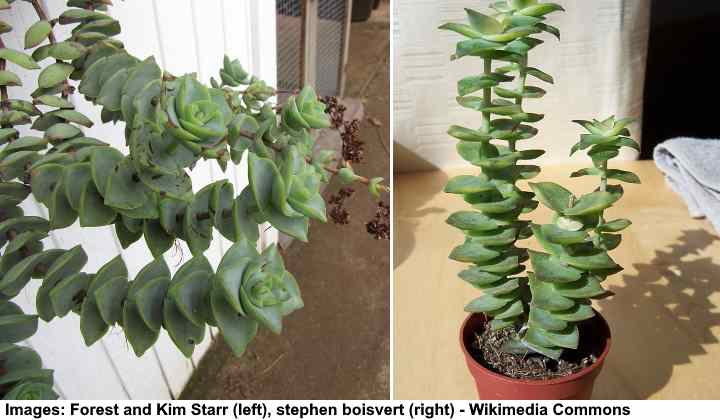
String of buttons young stems grow upright, but have trailing nature as they grow longer
String of Buttons is a fast-growing shrubby succulent with triangular-shaped leaves looking as if they are stacked on thick stems. The succulent leaves are a grayish-green color and sometimes have pink edges growing in a spiral pattern around the stem. String of Buttons blooms occasionally, but the yellow flowers are relatively insignificant.
At first, String of Buttons looks like an upward-growing plant. As the fleshy stems grow longer, they start to hang down over the edge of containers. The fascinating pendulous succulent stems grow up to 2 ft. (60 cm) long as they dangle downward.
Also called Necklace Vine, Crassula perforata grows best outdoors in zones 9 through 12. Plant in rock gardens, hanging baskets, ground cover, or as a shrubby succulent.
Burro’s Tail (Sedum morganianum)
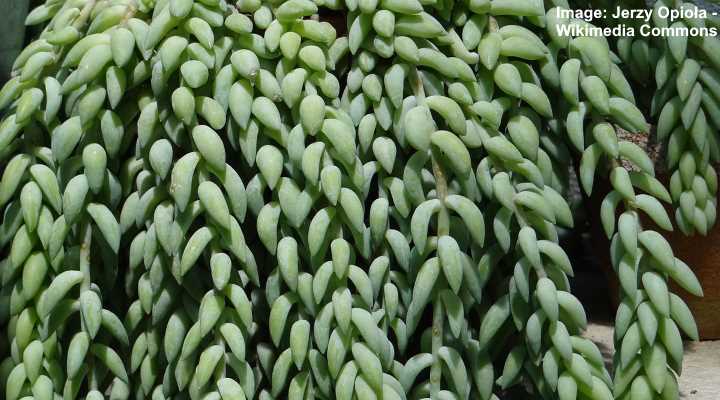
Burro’s tail is an attractive hanging succulent plant with cascading stems
Burro’s Tail is a decorative trailing succulent with thick stems, covered in fleshy, bluish-green plump leaves. The small fleshy lance-shaped leaves grow tightly on the stems. The pendulous stems grow up to 4 ft. (1.2 m) long, and reddish-purple flowers bloom in summer.
It’s easy to see how Sedum morganianum gets its name “Burro’s Tail” as the cascading stems look like braided tails. Other names for this hanging basket succulent are Donkey’s Tail or Lamb’s Tail.
Burro’s Tail is easy to grow indoors if it gets plenty of sunlight. The hanging succulent can survive with little water—in fact, the hardy succulent almost thrives on neglect.
String of Hearts (Ceropegia woodii)
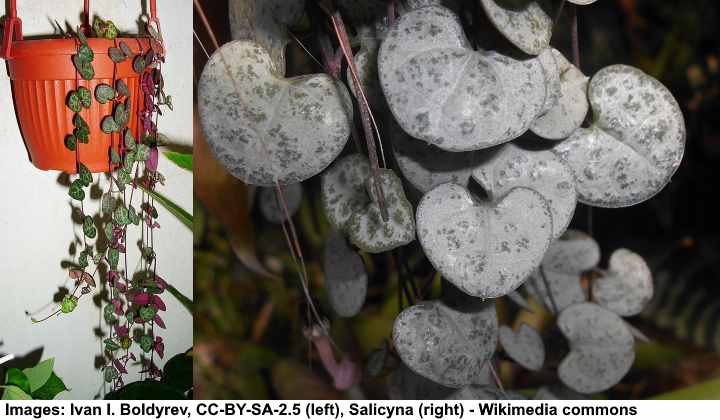
The delicate dangling stems of string of hearts succulent look very attractive in hanging baskets
String of Hearts is a succulent for hanging baskets with slender purple dangling vines that grow small silvery-green heart-shaped flowers. The wispy vines grow from tuberous roots and can reach up to 2 ft. (60 cm) long indoors. Ceropegia woodii also produces pinkish flowers in the shape of small tubes.
The String of Hearts vining succulent is known by other common names, such as Rosary Vine, Sweetheart Vine, and Chain of Hearts. Variegated varieties of Ceropegia woodii have pink and cream variegation on dark green heart-shaped leaves.
Trailing Jade Vine (Kleinia petraea)
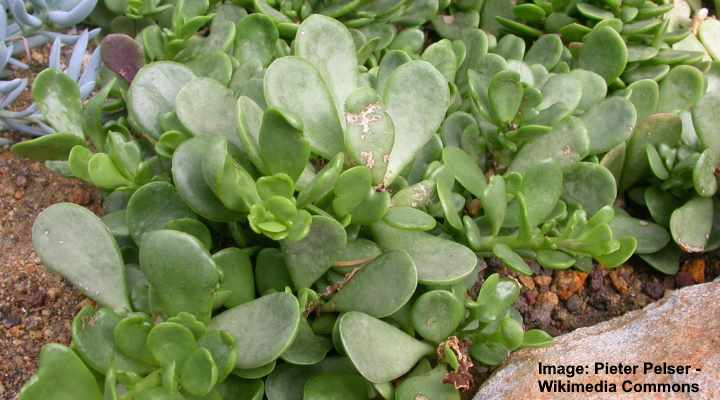
Trailing jade vine drape beautifully over hanging baskets or can be used as a ground cover
Trailing Jade is a succulent that grows well in hanging baskets due to its long, dangling fleshy stems and large oval leaves. Trailing Jade leaves are spatula-shaped and grow up to 3” (7.5 cm) long. The clumping succulent grows a mass of foliage that drapes over pots or spreads on the ground.
Trailing Jade Vine’s interesting feature is their fleshy oval leaves and showy orange flowers that grow upright.
Although called a jade plant, the succulent isn’t related to types of jade plants in the genus Crassula which are also called Money Plants and are said to be plants that bring good luck.
You can grow Trailing Jade hanging succulents in baskets outdoors in a sunny spot if there’s no danger of frost.
Little Pickles Plant (Othonna capensis)
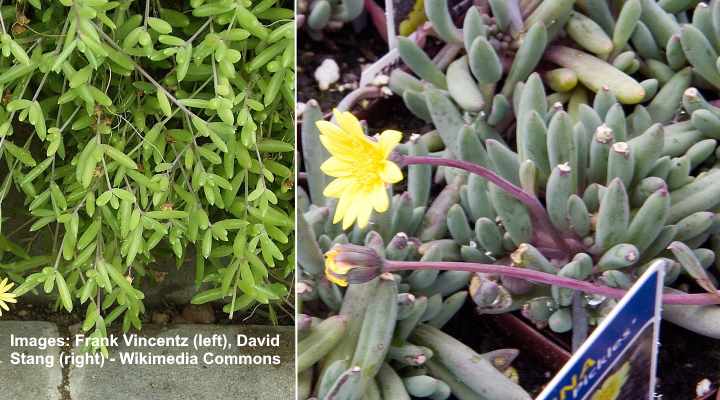
Little pickles plant is a flowering succulent with dangling stems
Also called Ruby Necklace, the Little Pickles Plant is a cascading succulent with wiry purple stems and small oblong fleshy green leaves. The “string of pickles” evergreen succulent’s finger-like leaves resemble tiny pickles growing on 1-foot (30-cm) long stems. This trailing houseplant produces dainty yellow daisy-like flowers that can bloom in spring and summer.
Ruby Necklace plant’s decorative feature is its combination of purple or red stems, plump green leaves, and yellow star-shaped flowers when the plant is in bloom.
The Hindu Rope Trailing Succulent (Hoya carnosa)
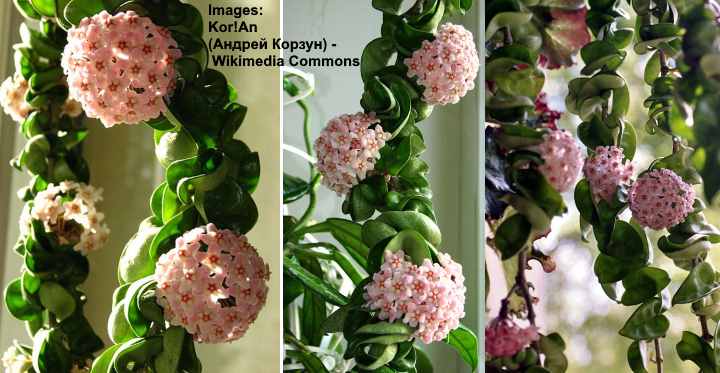
The curled and twisted leaves of the Hindu rope plant give unusual look to a hanging basket
The Hindu Rope plant is an attractive hanging succulent with waxy leaves and beautiful pink and red porcelain flowers. The slender woody Hoya vining stems grow up to 4 ft. (1.2 m) with large glossy oval or heart-shaped leaves that are up to 5” (13 cm) long.
Also called the wax plant, the Hindu Rope plant has beautiful clusters of star-shaped flowers. The fragrant flower clusters grow in an umbrella shape and can be white or light pink with dark pink or red centers.
Due to the crinkled succulent green leaves, the Hindu Rope plant is also called the Krinkle Kurl plant. There are also variegated varieties of this plant that have golden yellow and light green leaves.
Although preferring bright light, the Hindu Rope is a plant that grows well in rooms with minimal sunlight.
Trailing Wax Plant (Hoya pachyclada)
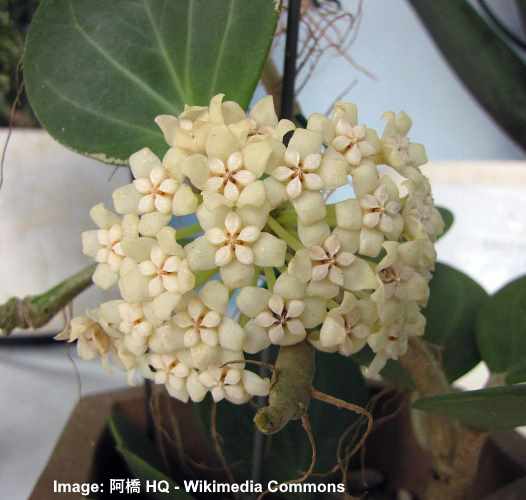
The trailing wax plant can grow outdoors in warm temperatures
The Trailing Wax plant is a slow-growing plant in the Hoya genus with thick woody stems, fleshy oval green leaves, and clusters of white flowers. The trailing succulent’s leaves grow densely on the short stems, giving this hanging Hoya plant a compact look. Growing in ideal conditions, the thick leaves have a red tinge around the edges.
Trailing Wax plants only grow outdoors in zone 11. You can place the hanging basket Hoya outside in a sunny spot during warm summer days. Water the wax plant occasionally when the soil is almost dry.
Related reading: How to care for wax plants.
Calico Kitten (Crassula pellucida ‘Variegata’)
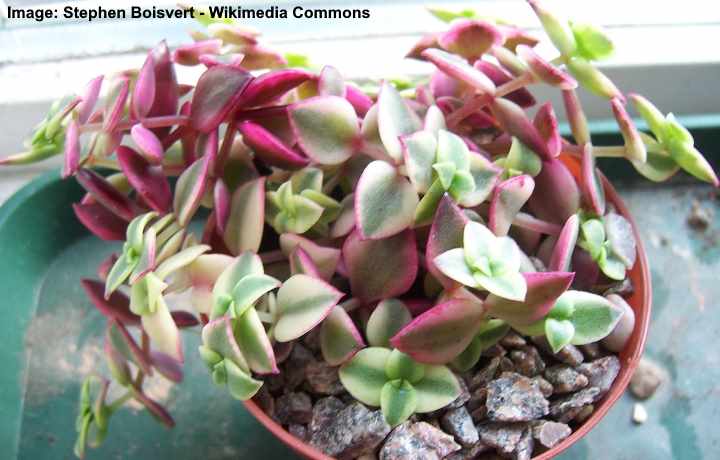
The colorful leaves of calico kitten add decorative touch to a hanging basket or as a ground cover
Calico Kitten is a cascading succulent with dangling stems featuring masses of small creamy and light green elliptic leaves. Growing in bright sunlight, Calico Kitten leaves have a rosy-red margin. Calico Kitten is a spreading succulent that quickly forms a clump of pendulous vines when growing in hanging baskets.
Calico Kitten stems grow up to 1 ft. (30 cm) long with evergreen foliage and showy flowers.
Crassula pellucida also grows outdoors in zones 9 through 11. In the garden, Calico Kitten grows best as a creeping, ground cover succulent for rock gardens.
Lantern Flower (Ceropegia haygarthii)
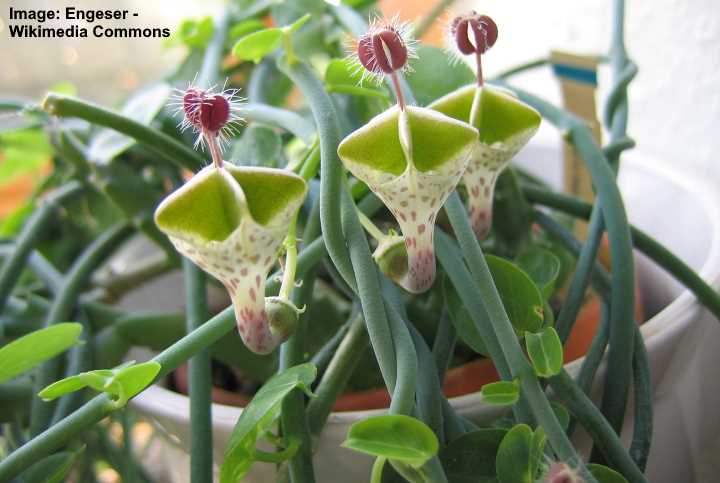
The unusual and unique flowers of Ceropegia haygarthii add interest to any hanging basket
The Lantern Flower plant is a vining succulent with trailing or climbing stems, small, ovate leaves, and small funnel-like flowers. The twining stems give the hanging succulent a compact look. Draping over the container’s edge, the long stems can reach up to 10 ft. (3 m) long.
The unusual feature of the Lantern Flower is its fascinating blooms. The spotted flowers have a cage-like top to catch insects and a protruding reddish-purple stamen with small spines.
Hanging Cacti
There are several hanging cactus plants with draping stems that are well-suited for growing in hanging baskets. Generally, indoor hanging cacti require less care than other types of succulents. The cacti soil should be loose and well-draining. You only need to water cacti when the potting mix is almost dry.
Related reading: How to care for cactus houseplants.
Rat Tail Cactus (Aporocactus flagelliformis)

Rat tail is a hanging cactus with attractive pink flowers and thick dangling stems
Rat Tail is a flowering cactus with long, thick cylindrical stems that arch over the side of pots and dangle down about 6.5 ft. (2 m) or more. The cactus tube-like stems have a fuzzy appearance due to fine spines covering the fleshy stems. Rat Tail cactus has beautiful pink or purple flowers that are around 4” (10 cm) long and 1.5” (4 cm) wide.
Rat Tail cacti grow best in hanging baskets or in a pot on a high shelf to allow the draping cactus stems room to grow.
Monkey’s Tail Hanging Cactus (Hildewintera colademononis)
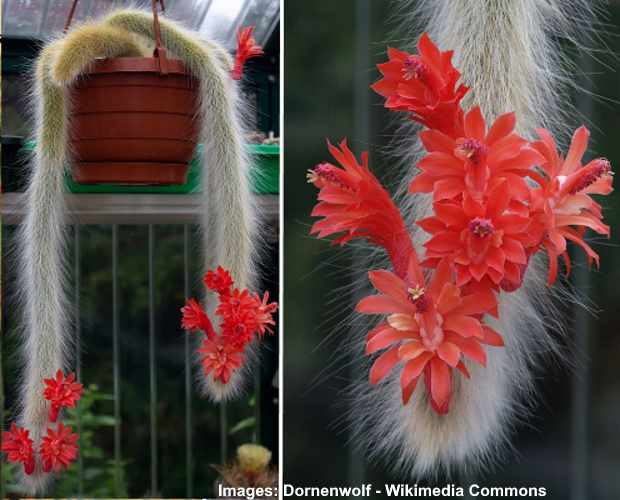
Monkey’s tail hanging cactus plant has hairy cascading stems and stunning red flowers
Monkey’s Tail is a hanging basket cactus with long hairy stems growing up to 3 ft. (1 m) long. The Monkey’s Tail cylinder-shaped stems are covered in white or golden hair-like spines that look like a monkey’s tail. The hanging cactus produces stunning decorative red flowers that contrast with the fuzzy cactus appearance.
Like most cactus plants, Monkey’s Tail is easy to care for. Grow in sandy soil that has excellent drainage and water whenever the soil dries.
Queen of the Night (Epiphyllum oxypetalum)
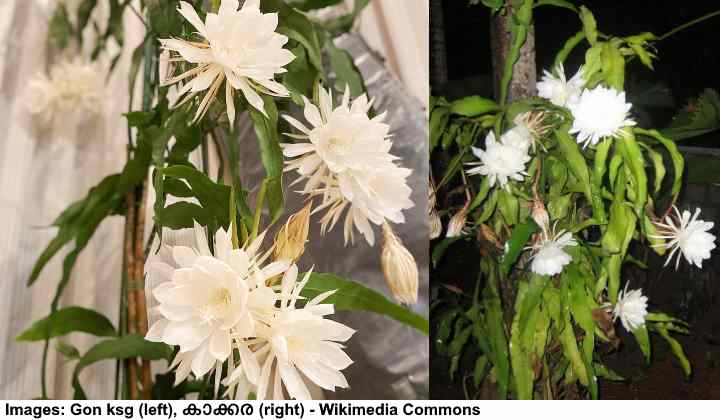
Queen of the night hanging cactus has beautiful white flowers that bloom during the night
Queen of the Night is a rare, majestic cactus plant with sprawling flattened, waxy stems and spectacular showy white flowers. The cactus stems grow between 1 and 3 ft. (0.3 – 1 m) long, and the bushy cactus has a spread up to 3 ft. (1 m). The beautiful, brilliant white fragrant flowers are up to 6” (15 cm) wide and grow on the end of 1-foot (30-cm) long stems.
The fascinating feature of Queen of the Night is that its extraordinary, plate-sized flowers only bloom during nighttime hours. This nocturnal cactus only blooms once a year after dark. To get Queen of the Night to bloom, it needs cooler temperatures during winter.
Other names for this rare hanging succulent are Lady of the Night, Dutchman’s Pipe Cactus, and Night-Blooming Cereus.
Related articles:
- The Best Flowers for Hanging Baskets
- Types of Succulents: Species, Varieties, Identification
- 14 Types of Cacti for Indoors and Outdoors
